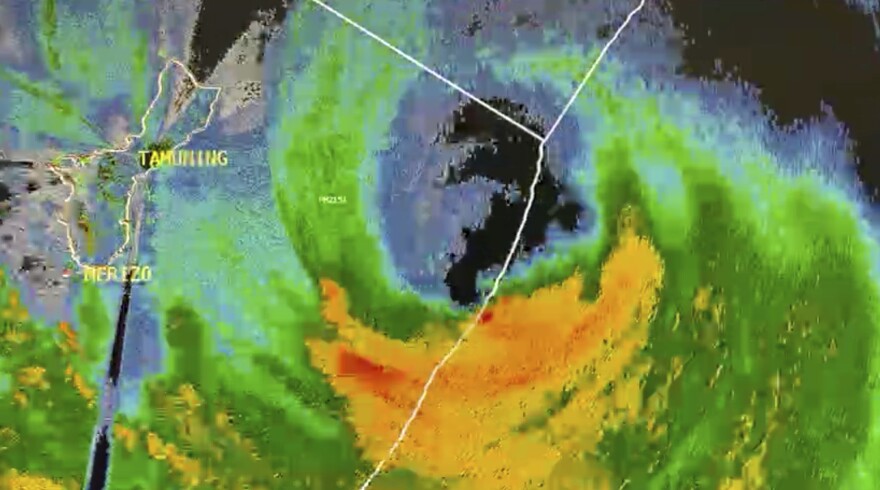Updated May 24, 2023 at 10:34 AM ET
Typhoon Mawar lashed Guam as a Category 4 storm on Wednesday local time, unleashing strong winds, heavy rains and widespread power outages in what forecasters are calling the strongest tropical cyclone to hit the U.S. island territory in decades.
The storm clipped northern Guam and is moving away from the island as of Wednesday evening, according to the National Weather Service (NWS). Its maximum sustained winds remain at 140 mph and are expected to grow as it slowly makes its way northwest.
"Mawar is forecast to intensify slowly over the next few days, possibly becoming a Super Typhoon over the Philippine Sea well west of the Marianas," the NWS says.
Forecasters had warned of a "triple threat" with powerful winds, torrential rain and "life-threatening storm surge," and said it could be the strongest storm to hit the island in 60 years.
Gov. Lou Leon Guerrero remembers experiencing Typhoon Karen — the most powerful tropical cyclone to hit Guam, with winds up to 175 miles per hour — in 1962.
"The whole island was really flattened by that typhoon, so to me that's the most scary," she told Morning Edition on Wednesday. "This one, as governor ... what's making me much more anxious is the safety and the protection of our people with these storms, because we know that we can't leave 'cause we're in the storm for about 12 hours."
It's too dark and dangerous to begin damage assessments
Guam remains under flash flood and extreme wind warnings, and it may be some time until the full extent of the damage is known.
Guerrero said she will have her first damage assessment as soon as the winds start tapering down, but already knows of damage to houses and at least one rescue mission in which eight people were taken to a shelter.
"It was pretty scary going into a Category 4 to almost a Super Typhoon, but our people are very resilient," Guerrero added.
What's clear is that most of the island is in the dark. Guam Power Authority said in an afternoon update that almost all of its circuits were without power, and that the island-wide power system was serving only about 1,000 of its approximately 52,000 customers.
"I don't know that anybody still has power," says Dana Williams, who is in Guam covering the storm for the Pacific Daily News.
Williams told Morning Edition on Wednesday that the island — which covers an area of some 210 square miles — was seeing heavy rain, coastal flooding, high seas, downed trees and internet outages.
Forecasters had been warning that anyone who didn't shelter in a reinforced concrete structure risked serious injury or death, she added. (Building codes have required all homes be made of concrete since 2002, the Associated Press notes.) Fortunately, Williams said, people living in Guam take these precautions seriously.
"This is not like Florida, where you can drive inland 10 miles, or even drive to Georgia," she explained. "I mean, the flights shut down yesterday. We're here and ... we've got to follow directions, and stay in our homes and go to places with shelter and get away from the water and stay off the roads. So most people do that."

Federal help is already on the way
Residents had been preparing for days, the AP reports, filling up gas tanks and gathering important documents.
Federal officials had also acted quickly — the U.S. military sent ships away from Guam as a precaution, while President Biden approved an emergency declaration on Tuesday authorizing the Federal Emergency Management Agency (FEMA) to respond to the disaster.
FEMA Associate Administrator Anne Bink told NPR's All Things Considered on Tuesday that the agency had already pre-staged over 100 staff members — including medical professionals and power restoration experts — as well as relief supplies, with more than a million liters of water and 700,000 meals ready at a distribution center in Guam.
That positions FEMA to help with damage assessment and recovery as quickly as possible, Bink says. She says Guam's relationship to the federal government — since it's a territory and not a state — doesn't factor into the relief efforts, though its location in the far Pacific does pose some logistical challenges.
"That's why we have a distribution center there. And that's why a regional administrator meets with ... island leadership every year to make sure that ... efforts made to prepare for disasters and be resilient against them are shared," she explains. "In fact, Guam has mostly concrete infrastructure, including concrete power poles, and that can go a long way in the face of a storm of this magnitude."
Guerrero says she's grateful to Biden and FEMA for their help, and agrees that Guam's status doesn't change anything when it comes to relief. She says the agency's response is comparable to that for other weather emergencies, like hurricanes, in the continental U.S.
"If anything, I think that we get more support quickly because of our isolated area, because we don't have the help of, say, other states bringing other resources to us," she adds.
That process likely won't start until sunrise at the earliest. Forecasters tell the AP and the New York Times that storm conditions are expected to linger in Guam until Thursday morning local time.
The Guerrero broadcast interview was produced by Shelby Hawkins and Adam Bearne, and edited by Jan Johnson.
Copyright 2023 NPR. To see more, visit https://www.npr.org.


